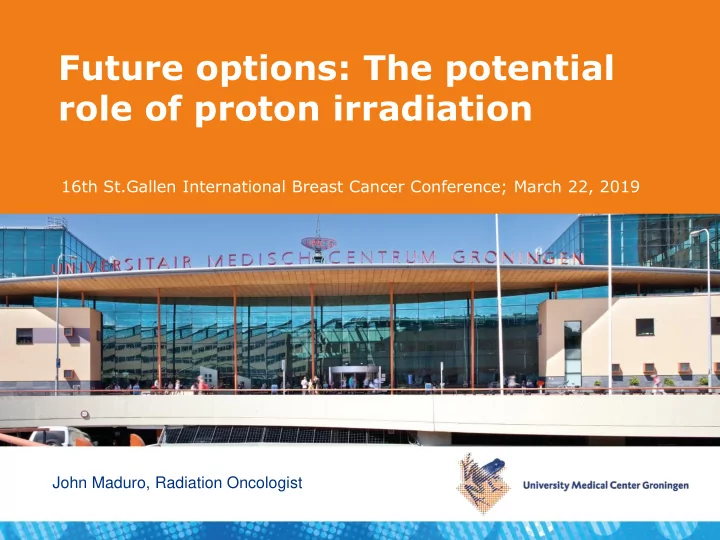

Future options: The potential role of proton irradiation 16th St.Gallen International Breast Cancer Conference; March 22, 2019 John Maduro, Radiation Oncologist
Introduction • Should proton irradiation be the treatment of choice for locoregional irradiation in breast cancer patients? • Yes, but……… It is not a matter of caution but selection! 2
Physical properties • Photons (x-rays) • Protons 3
Physical properties 200 180 160 Photon Spread out 140 Bragg Peak 120 Proton 100 80 Proton 60 Bragg Peak Proton 40 Proton 20 Depth (cm ) 5 10 15 20 25 30 Skin 4
Why in breast cancer? 5
Cardiac toxicity Heart failure Ischaemic heart disease Valvular heart disease Boekel et al, Br J Cancer 2018 6
Tumor induction Tumor RR All cancers* 1.12 (95% CI: 1.06 to 1.19) Lung cancer* 1.39 (95% CI: 1.28 to 1.51) Esophageal cancer* 1.53 (95% CI: 1.01 to 2.31) Contralateral BC # (age <40yrs) 2.5 (95% CI: 1.4 to 4.5) * Grantzau et al, Radiother Oncol 2015, # Stovall et al, IJROBP 2008 7
Organs at risk 8
Dose distribution 9
Dose to organs at risk Mean dose (Gy) Organ Photon Proton Heart 6.53 0.02 LAD 24.98 0.27 Left lung 8.12 0.87 Right lung 1.07 0 Right breast 1.56 0.17 10
Dose to organs at risk 2.0 Gy 1.7 Gy Dasu et al, Physica Medica 2018 Pierce et al, IJROBP 2017 11
Plan comparative studies • Lower dose in: Heart ─ Lung(s) ─ Contralateral breast ─ Shoulder muscles ─ Ares et al, IJROBP 2010; MacDonald et al, Radiother Oncol 2013; Mast et al, Breast Canc Res Treat 2014; Farace et al, Br J Radiol 2015 12
Why not in breast cancer? 13
Availability and cost 2019: +33 2017: +199,845 Website PTCOG, March 2019; Jermann et al, Int J Particle Therapy 2015; Zubizarreta et al, Clinical Oncology 2017 14
No randomized controlled trials 15
Most patients will not have a clinical benefit • Low dose to heart and lung in most breast cancer patients Breast only ─ Partial breast ─ Breath hold ─ Prone position ─ Right sided breast cancer ─ 16
What’s the literature? 17
Clinical experience • Older proton technique (passive scattering) Higher skin toxicity ─ • Partial breast Excellent local control ─ Good cosmetic result(except patients 8 fractions twice daily) ─ • Whole breast/chest wall Feasible and well tolerated ─ • Ongoing RCT’s Teichman et al, Cancer Med 2018; Luo et al, Radiother Oncol 2019;, Verma et al, Radiother Oncol 2017; Gallant-Girodet et al, IJROBP 2014; MacDonald et al, IJROBP 2013 18
Clinical data • National Cancer database (United States) 2004 – 2014 ─ 871 (0.1%) proton RT, 723,621 non proton RT ─ 58.3 % stage 0-1 ─ Median follow up: 62.2 months ─ Equal overall survival ─ Chowdhary et al, Frontiers in Oncology 2019 19
How to select? 20
Dutch model for patient selection Langendijk et al, Radiother and Oncology 2013 21
Model based selection • Dose effect relation (normal tissue complication probability (NTCP)) • Individual risk calculation • Cardiac risk photons – Cardiac risk protons > 2% 22
Cardiac risk model Life time: 7.4% per Gy 23
Individual cardiac risk • Individual risk based on national cardiac events statistics Age ─ Presence or absence of cardiac risk factor ─ Mean heart dose ─ 24
Example • 40 year female patient with cardiac risk factor • Photon plan Mean heart Cardiac event dose (Gy) risk (%) Photons 5.0 4.3 Protons ∆ NTCP 25
Example • 40 year female patient with cardiac risk factor • Proton plan Mean heart Cardiac event dose (Gy) risk (%) Photons 5.0 4.3 Protons 1.0 0.6 ∆ NTCP 3.7 26
Patients that could benefit • Internal mammary chain irradiation • Young patients • Bilateral breast cancer • Special anatomy (pectus excavatum) • Cardiac risk factor 27
Conclusions • Dosimetric all breast cancer patients benefit from proton irradiation (ALARA) • Not all breast cancer patient should get protons Cost effectivness ─ • Some breast cancer patients will have a clinical benefit Adequate patient selection ─ • Life expectancy • Relative higher dose to organs at risk 28
Acknowledgment Anne Crijns, UMCG Hans Langendijk, UMCG Liesbeth Boersma, MAASTRO Karolien Verhoeven, MAASTRO Dutch National breast proton indication committee 29
Recommend
More recommend